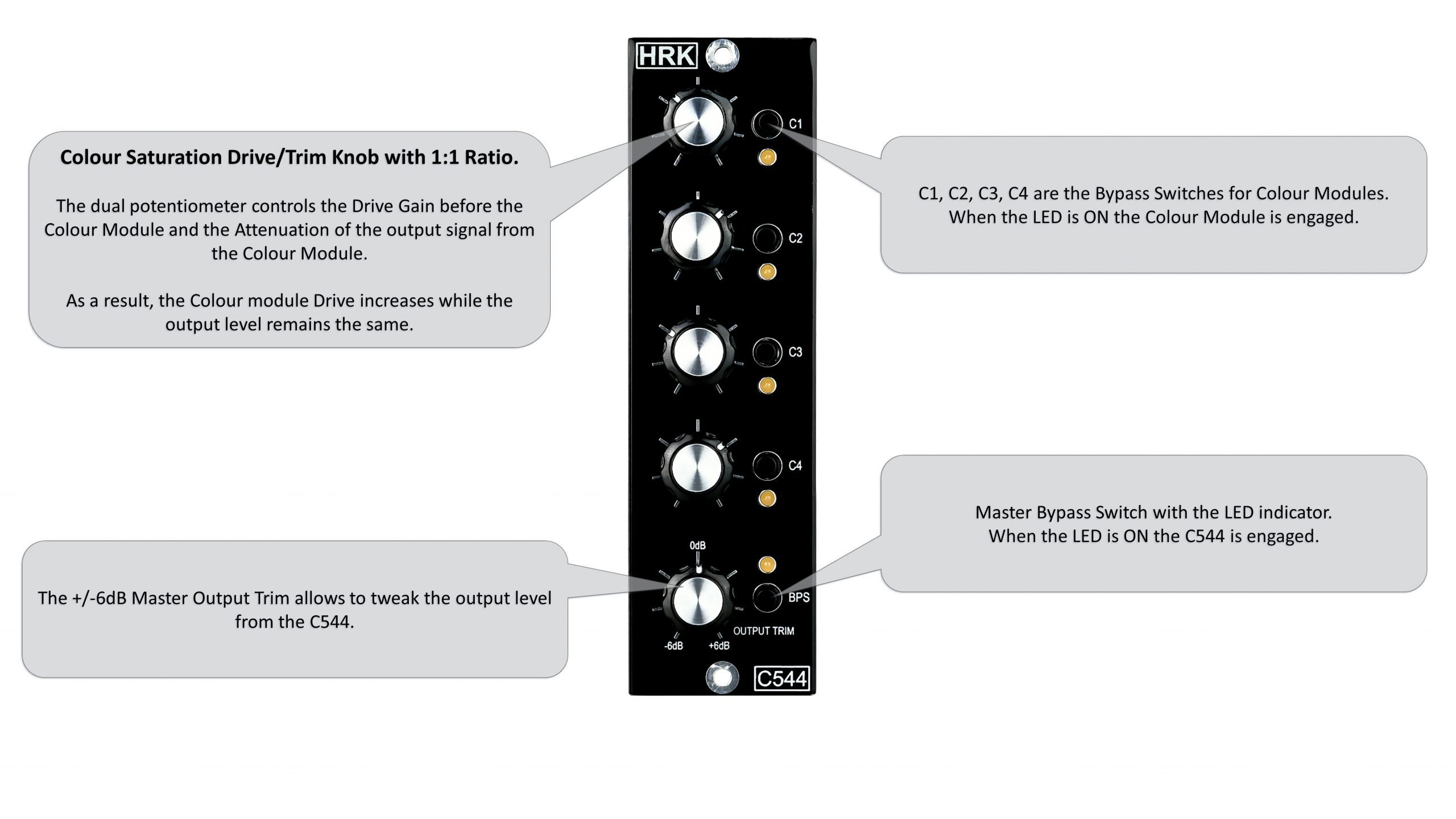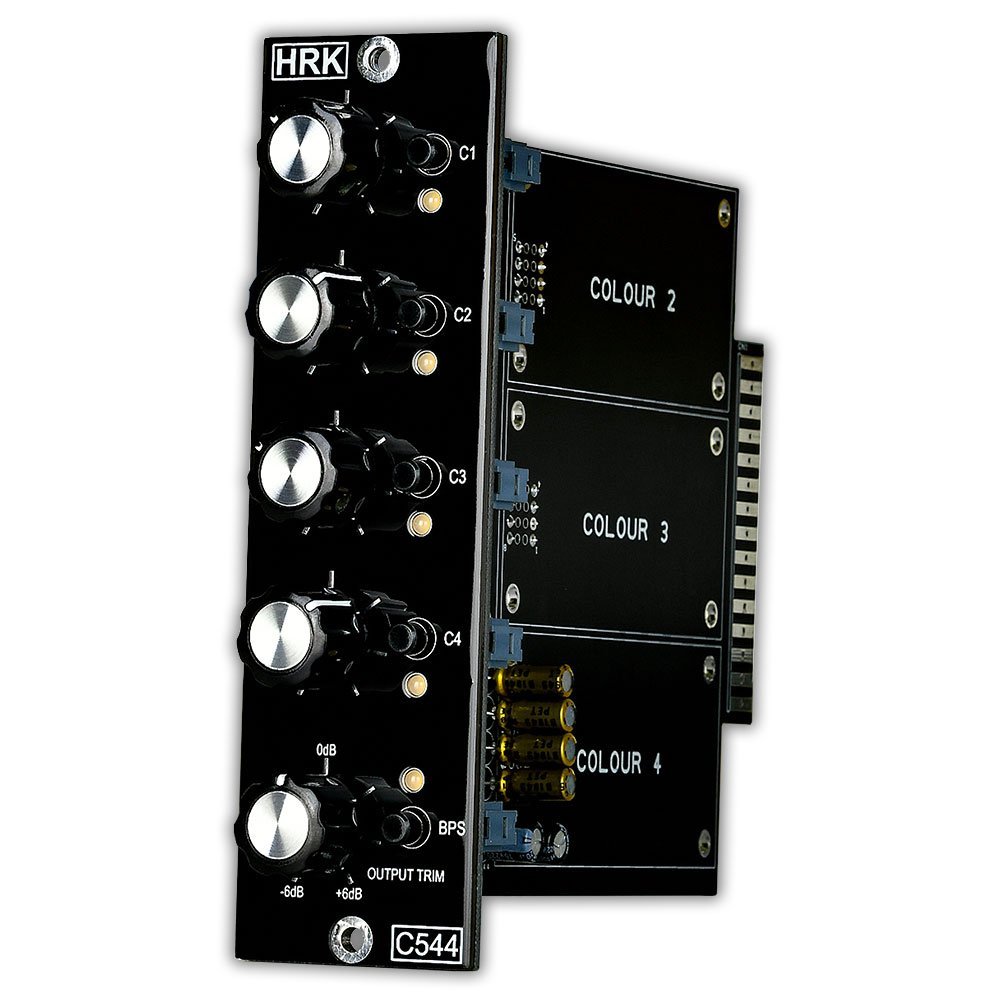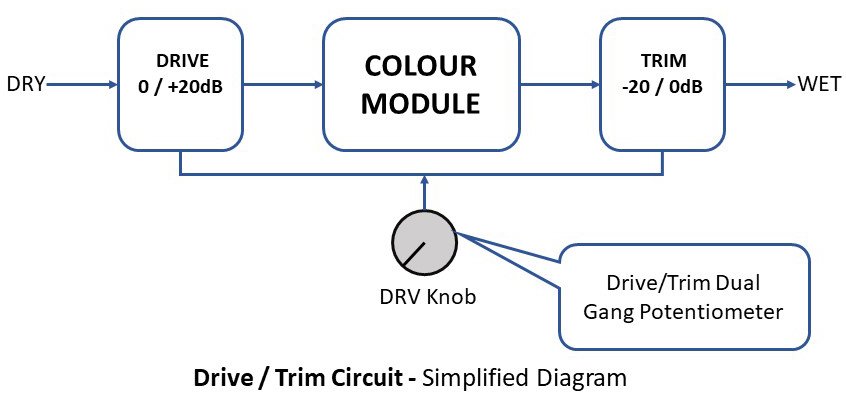C544 User Manual – Legacy Product
0. Read First!
If you use the Interface MIC input to connect the C544, remember to switch OFF the PHANTOM POWER! Phantom power may damage the output of the C544!
DO NOT USE unbalanced cables to connect the C544 – you may get the level, phase and ground loops problems. DO NOT connect the unbalanced cables to the OUTPUT of the C544 – you may damage the C544 output!
Each Colour Module section contains the opamp based Drive/Trim circuitry which provides the gain of up to +20dB. This means that the opamps may be overdriven even if the colour modules are not engaged.
If you hear the distortions, even if the colour modules are disengaged, reduce the level of the signal from DAW. Remember, MORE does not mean BETTER!
Some colour modules require only little gain or drive to achieve great results; other colours have to be driven a bit harder. Drive/Trim knob has a range, which means that it DOES NOT have to be on the MAXIMUM every time… 😉
If you use the interface MIC input set the GAIN to a minimum. DO NOT use the MIC input PAD function. PAD will deteriorate the Signal-to-Noise ratio! Use only the native/active line input if possible.
Cheap audio interfaces emulate the Line Input function by using the PAD attenuator with the standard MIC input. It is better to use the MIC input with minimum GAIN and reduce the output level from C544 if necessary.
Such a solution will result in a better Signal-to-Noise ratio and overall better sound quality.
The C544 is professional studio equipment. The user should read and learn the basics of audio engineering before the use of any studio equipment.
Improper use or lack of basic knowledge will result in unwanted results or cause of damage to your studio equipment.
1. GENERAL
The C544 is a mono four slots colour processor. The C544 is fully compatible with the DIYRE Colour Format and The DIYRE Colour Modules.
The C544 is designed to process the line-level signals from the DAW system or the other line-level source.
Each colour slot has an independent Drive/Trim control knob section and the Colour Module bypass switch – C1, C2, C3, C4.
To engage the colour module, flip the bypass (C1 – C4) switch upwards. If the colour module is inserted into the colour socket the signal will pass. If the colour module is not present or not inserted correctly, the signal will be interrupted – no sound.
Colour modules are connected in series. No parallel signal routing is possible. Signal will be affected first by the Colour Module 1 and passed to the next colour module inserted in the following colour slot.
The Master Output section has the +/-6dB master output trim, master bypass switch and the LED indicator.

2. The Drive/Trim Operation – Each Colour Module
Each Drive/Trim Colour Module section has the independent active Drive circuitry with +20dB gain which can be used to saturate the colour module. The Trim part of the section is placed after the colour module.
The Drive/Trim is using one dual-gang potentiometer. If the Drive gain increases the Trim reduces the signal from the colour module by the same dB value. As a result, the absolute output signal level remains equal to the input signal.
Some colour modules can clip the signal due to the limited headroom or the used components. Clipping colour modules, such as Discrete Saturation, may act as a primitive limiter. Further increase of the input signal will not increase the overall output signal level.
In such a case, the output level from the colour module may be lower than the input level, while the distortions level will increase.
The Drive/Trim knobs should be used with caution. Some colour modules cut off the signal if driven too hard. In a severe case, a high signal level may damage the colour module.
Important Note!
The most common mistake made by the users so far is overdriving the Colour Processors with a too high-level signal sent from the DAW! Each colour module stage in the C544 provides +20dB of Gain. This means it increases the input signal level up to 10 times. You must reduce the signal sent to the C544! The C544 is not a vintage transformer or valve preamp which will sound good if driven hard… It is a piece of modern studio equipment that has a headroom limit. It will clip at some point and it will produce audible, most likely unpleasant distortions.
If you hear the distortions, even if the colour modules are disengaged, reduce the level of the signal from DAW. Remember, MORE does not mean BETTER!
First Use of C544:
-
Set all Drive/Trim knobs to a minimum.
-
Reduce the level from the DAW to -20dBu
-
Set Master Output knob to 12 o’clock – 0dB
-
Set all switches downwards (C1-4, BP)
-
Make sure that input and output is connected to correct sockets on the back of the 500rack
-
Play the test signal or track and confirm that the signal pass from input to output
-
Switch the BP upwards; the LED indicator should be ON
-
Confirm that the signal pass from input to output
-
Switch the C1-4 upwards, if the colour modules are inserted the signal should be present
-
Use the Drive/Trim knob to achieve the desired level of saturation.
-
Use the C1-4 switches to A/B the signal
-
Use the BP switch to A/B the C544 operation
-
In case of difference in level use the +/-6dB Master Output knob to compensate for the level difference.
Before the use of C544 turn all Drive/Trim knobs to a minimum. Reduce the output level of the DAW by -20dB. Make sure that all switches are in a LOW position (colour modules bypassed). Play the test 1kHz signal from DAW. Confirm that the signal returns to the DAW system.
Tip: Why you should not use the resistor mic input PAD.
The most common way of adding the Line Input functionality to the mic input of the Interface is the mic input PAD.
The mic input PAD is nothing more than resistors added on the input of the microphone preamplifier.
The signal is attenuated and again amplified by the microphone preamplifier. As a result, the signal-to-noise ratio is worsening.
Also, the impedance matching between the source and the mic preamp is disrupted causing unwanted frequency response issues.
© 2024 HRK Shop
User Information. This page uses cookies files to process the orders and deliver a better user experience.








